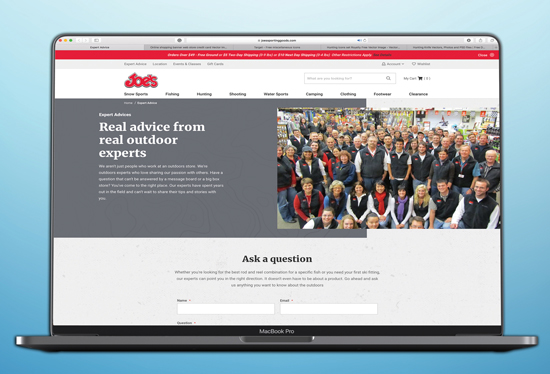A Proactive Approach To E-Commerce
5 Common Challenges, And Solutions To Overcome Them
Having a strong web presence to enhance a store’s brick-and-mortar offerings is no longer a question, but whether or not it involves branching out into e-commerce is based on your circumstances and business goals. In the Sept. 2018 issue, we highlighted 11 important areas to consider for blending brick-and-mortar and e-commerce in today’s market. Before jumping in, here are some of the common challenges you may face and solutions to overcome them.
Challenge: Technology Is Ever-Changing
When it comes to anything technology related — especially digital sales and marketing trends — the only permanent thing you can count on is change. Just when you think you have it all figured out, Google changes their algorithm, or your software service provider announces an upgrade.
The best solution to overcome this challenge is to invest in dedicated and qualified in-house personnel in the areas of information technology (IT) and digital marketing. If this isn’t feasible, consider hiring an agency.
Investing in someone who specializes in these areas will help ease the burden of having to keep up with technology trends yourself. Matt Poet, marketing director of Jay’s Sporting Good’s (with two locations in northern Michigan), recommends only entering the e-commerce arena if you have the time and resources to invest in it. “If you don’t or can’t do it right, it will hurt your business more than help it,” he cautions.
Challenge: Choosing The “Best-Fit”
Richard Sprague of Sprague’s Sports (Yuma, Ariz.) has relied on the same third-party software provider, Retail Technology Group (RTG), for more than 20 years because their support and costs of operation have been consistent and reliable. It’s vital to choose the best POS system for your needs, he says.
For Sprague, the features most important to him for his business were the startup and ongoing maintenance costs as well as support, reliability and user-friendliness. For you, especially if you are entering e-commerce for the first time, you may be more concerned with real-time inventory management or a cloud-based platform.
Sprague recommends asking for references and years of experience, then taking the time to talk with current users about their level of satisfaction. Only after doing so should you request a demo and quote for the initial system startup, installation and ongoing maintenance support. This process will take time and extensive research, but it will help ensure the best POS system for your specific needs is selected.
Challenge: Identifying The Right Product Selection
The product mix for your online store will vary from your brick-and-mortar store. Before launching an e-commerce site, first make sure existing in-store inventory is updated and organized.
“We have so many SKUs it’s hard to get a good product mix online that includes new product, has a fresh look and is a good representation of what we have displayed in-store for our customers to see,” Poet shared. “Unfortunately, we can’t display everything we carry in-store online.”
Jim Rauscher, president of Joe’s Sporting Goods (St. Paul, Minn.), said it is important to know your niche before deciding what inventory you want to showcase online.
“What sells best in-store isn’t necessarily what sells best online, and it’s just something you will learn over time,” he said. “For us, what seems to work best is choosing the top 20 percent of products in each category.”
Challenge: Attracting Online Customers
With e-commerce, there is the potential to attract customers both within your geographical market and beyond. But, marketing your website can be very different than the traditional marketing methods you are used to. In-store promotions and events may work well to get a customer through the doors, but how do you get them to your website?
This is where investing in an in-house digital marketing expert or partnering with a local, but experienced digital marketing agency comes back into play. Search engine algorithms change frequently, and key areas to invest in include search engine optimization, pay-per-click advertising such as Google AdWords and maybe even social media advertising. All of these methods can help drive traffic to your website.
The beauty of digital marketing is your efforts can be targeted to a specific group based on demographics, interests, buying behavior and countless other identifiers. This helps to ensure you aren’t wasting money advertising to people who couldn’t care less about your products. You even have the ability to retarget customers who have visited your site but left without making a purchase.
And, the best part about digital marketing is the results are much easier to track compared to traditional marketing like billboards and radio or television advertisements. “The analytics you receive are incredible,” Rauscher lends. “And they help give us a better understanding of who our customers are and what they want.”
Challenge: Creating A Customer Connection
It is far more challenging to create a customer connection with an online store than in-person.
“When I speak to a customer in-store, I’m able to share anecdotal first-person experiences about my own adventures using the products we carry to create a connection,” Rauscher said. “Each member of my sales team is able to do the same using their unique perspective. It helps build credibility and enhances our reputation as experts in our industry.”
But, how do you create the same personal connection through a computer, tablet or smartphone screen?
Though it takes more time than inputting manufacturer-provided product descriptions, the e-commerce team at Joe’s Sporting Goods writes customized descriptions for each product on the website. “This gives it a uniqueness and adds a personal twist,” Rauscher stated.
As often as possible, Rauscher also makes it a point to include value-added “gifts” in each online shipment aligning with the buyer’s interests. Someone who orders a shooting-related product might receive Joe’s Sporting Goods branded targets, whereas a snow sports enthusiast may receive branded stickers they can put on their snowboard or skis.
Challenge: Is The User Experience Smooth?
So, you’ve attracted visitors to your site and created a personal customer connection, but whether they keep coming back depends largely on the user experience of your website. Is it easy to navigate? Is the checkout process secure? Is the online store optimized for mobile devices?
To enhance the user experience beyond these basic features, the Joe’s Sporting Goods website offers an in-store pickup feature, free ground shipping on orders over $49, the ability to create a personalized wish list and free return shipping. But perhaps one of the site’s most unique offerings is the “Expert Advice” feature. Online shoppers can complete a simple three-field form to ask Joe’s outdoor experts questions such as what is the best ammunition to use for hunting a particular species, what scope is best for a specific firearm, or the best rod and reel combination for a specific fish. This feature enhances the user experience and gives online shopping a more personal feel.
Parting Thoughts
While online sales currently only make up an estimated 10 percent of Joe’s Sporting Goods’ total sales, investing in e-commerce has allowed them to sell to customers in all 50 states — an achievement not possible otherwise.
Whether you’re entering the e-commerce market for the first time or have been selling products online for years, the challenges remain the same. Hopefully, learning about how your peers overcome these common obstacles will help give you the confidence to explore your digital potential and take your business to new heights.






